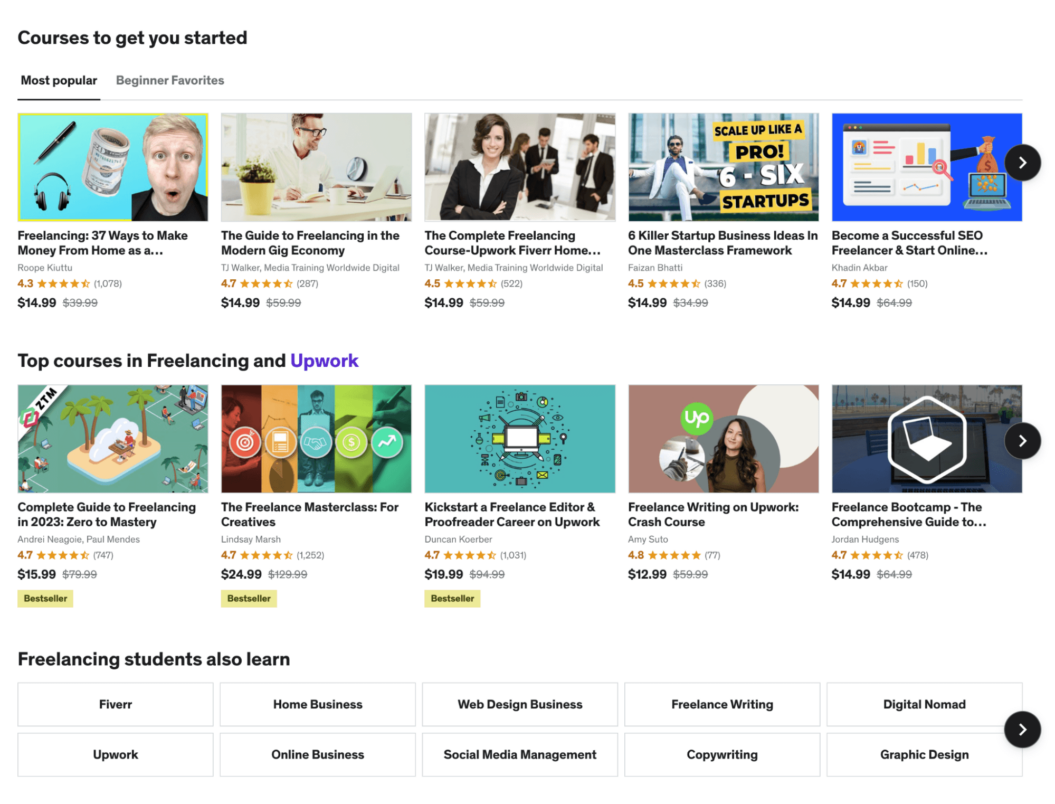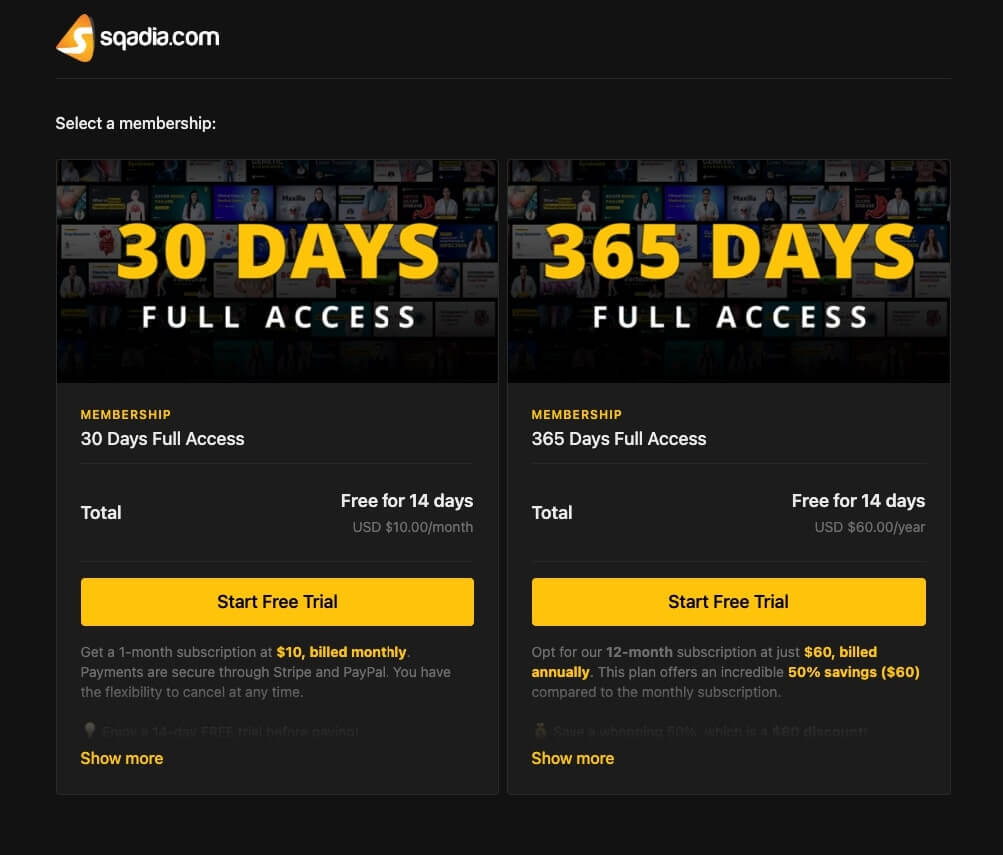Finding the perfect course price is hard to figure out.
Why? Because assigning value to your work is more than slapping a price tag on it. It’s a tightrope walk between what you think the work is worth, and what potential customers will pay.
From pricing courses at Peak Freelance, I’ve learned that it’s much easier to do with a proven framework. It also helps you make more money.
In this guide, I’ll walk you through how to do the same (in a few different ways), so you can get your money’s worth for the effort you’ve put in to creating an online course.
What impacts pricing online courses?
To launch a profitable course, you need to know what your course creation costs. To start your pricing journey, you need to think about: Experience, Time, Marketing Costs, Course Content, and Competition.
Let’s dive in.
Experience
Experience refers to the depth of your knowledge, skill, and expertise. It’s your:
- Professional background.
- Academic qualifications.
- Personal accomplishments.
- Demonstrated mastery of subject matter.
- Personal brand and brand recognition.
- Niche/category ownership.
Imagine two creators:
- John, a hobbyist who has been practicing for five years and has a small following on Instagram.
- Sarah, a professional photographer with 20 years of experience, has published books, and won a few awards.
While both creators can offer valuable insights, Sarah brings significantly more experience. Meaning the perceived value of Sarah’s course offerings is likely higher, and she can command a higher price for her course.
Time
The time you spend creating your online course should also be factored into the price-setting equation.
Consider:
- Creation: How long it took you to make the course, including planning, research, content creation, filming, editing, and setup.
- Management: The time spent managing the course, including answering student questions and marketing it.
- Updates: The time you will spend updating your courses regularly to stay relevant.
Marketing Costs
This refers to all the money you’ll spend promoting your online course: ads, email campaigns, SEO efforts, blog posts—everything.
Set an overall monthly budget and split it equally between your marketing channels to start. For example, when launching Freelance Writing Essentials we leaned into Facebook ads and content marketing, allocating 25% to ads and the rest to content.
Which meant that we could reach the highest quality audience for a manageable amount.
Keep in mind that marketing costs vary greatly depending on your strategy. Test a few, and once you have some that work, allocate more budget to them.
Course Content
Different course topics have different markets. The value learners place on that knowledge varies widely.
A course’s perceived value is directly related to its complexity and professional application. For instance, an advanced business strategy course will be more expensive than a beginner’s guitar course.
Here are three examples:
| Course | Skill level | Prerequisites | Audience size | Price |
| Yoga | Beginner | None | High | Low |
| Programming | Intermediate | Coding Knowledge | Medium | Mid-range |
| Corporate Financial Analysis | Advanced | Finance background | Low | High |
- Yoga course for beginners with no prerequisites. Considering the broad appeal and low barrier to entry, the price will be lower, but the number of potential students will be higher.
- Programming course for intermediates. This course is for people with coding knowledge looking to enhance their skills. It’ll have a higher perceived value and will cost more.
- Advanced corporate financial analysis course. This course targets a narrow target audience, but these professionals are happy to invest more in high-quality courses to excel in their careers. Despite having fewer students, you can charge significantly more than a beginner’s course.
Look at this factor through the lens of potential impact, or how your course can transform someone’s life.
Competition
You’re going to have competitors for any course you launch. Competition comes from all angles, Udemy, Coursera, other creators, and even your friends!
When the team at Peak Freelance re-launched Creative Class, an advanced course for freelancers, there were plenty of options available to buyers. So in order to figure out how to position our course properly we needed to understand our competitors.
To learn more, we first looked at Udemy. On Udemy alone, hundreds of freelancing programs and mini-courses were available, at much lower prices than we’d charge.

The Udemy courses under $50 were short and less comprehensive. And other than Seth Godin, who sells his freelancing course for $199, none of the authors stood out.
Since Creative Class is taught by big industry names like Paul Jarvis and Kaleigh Moore, we knew a high price was reasonable. Our course sells for $269, a great supplemental income to our primary membership offering at Peak Freelance.

💡 TAKE ACTION:
- Browse leading marketplaces like Udemy and Coursera.
- Make a list of competitors in your niche.
- Find out what they are charging and their offerings.
- Read what customers say about their pricing.
- And be strategic.
If you can offer more value or unique insights, you can justify a higher price point.
Methods to price your online course
Now that you know what goes into your pricing, let’s look at the different methods available to figure pricing out.
Cost
Cost-based pricing is the most straightforward way to price your course. It means adding upthe total cost of creating and maintaining the course, and adding a profit margin on top to setyour final price.
Using cost-based pricing guarantees:
- You cover expenses.
- You keep making a profit..
Many creators use cost-based because it’s simple and predictable. It helps you forecast your finances, as long as you understand all your costs for content creation, software, marketing, and taxes.
💡 TAKE ACTION:
- Add up all these costs to determine the total cost of your course.
- Decide your profit margin.
- Use the formula: Total Cost / (1 – Profit Margin) to calculate your course price.
Competitive
Competitive-based involves pricing your course based on other prices in the marketplace.
Imagine you’re a fitness instructor launching your first online course on “Holistic Fitness and Wellness.” Before setting your price, look at the market and explore similar courses.
You find:
- Course A, which covers only physical fitness, is $100.
- Course B, which covers physical fitness and diet, is $150.
- Course C, which covers physical fitness, diet, and mental wellness, is $200.
Given that your course also covers all three areas (physical fitness, diet, and mental wellness), you may price your course around the same range as Course C. However, if you have unique features or benefits that Course C doesn’t offer, price your course slightly higher to reflect that additional value.
💡 TAKE ACTION:
- Find out how much your competitors charge for their courses.
- Do a like for like comparison of their course content, the level of support or interaction they offer, and any additional resources or bonuses included in a premium price.
- Based on your research and evaluation, decide on a competitive price for your course.
Value
Value pricing is a tough one, but works when done right. It refers to pricing your course based on your customers’ perceived value rather than the development cost.
Say you create a dance instructor bootcamp that guarantees students a job post completion. If a student with little dancing skills lands a job paying $75,000 a year after taking your course, the perceived value is extremely high.
If you price the course at $1,000, it may seem like a lot, but when measured against a $75,000 return, it’s worthwhile for the student.
💡 TAKE ACTION:
- Ask yourself what someone might be willing to pay for your course’s benefits.
- Find out what other similar courses charge, but don’t just copy their pricing. Understand the value proposition of your competitors and how yours differs.
- Experiment with different price points and see how your market responds.
- Make sure potential students understand the value they are getting. This means you’ll need a strong marketing and sales strategy.
Subscription
The subscription business model is my personal favorite. It refers to charging students a recurring fee (monthly or annually) to access course materials. Most Peak Freelance courses and masterclasses are included in our membership fee, which is $49 per month.
Consider a membership site like Sqadia. You don’t pay for each series you watch, but a monthly fee gives you access to their entire library of medical courses.

Subscription, or membership, pricing is appealing if you offer a wide range of courses, or provide regular new content for subscribers. Many video creators opt for a subscription-based pricing model to earn consistent revenue and stay competitive.
💡 TAKE ACTION:
- Look at the number of courses you offer, the frequency of updates, and the breadth of the topics covered. The more diverse and extensive your offerings, the more attractive a subscription model can be to students.
- Factor in the costs of producing and maintaining your courses, and any platform or transaction fees. Your payment plans need to cover these costs and provide you with a profit margin.
- Consider offering different pricing tiers of subscriptions. For example, a basic tier might offer access to the course materials, while a premium tier could include additional benefits like one-on-one consultations, community, or early access to new courses.
Use our free tool to pinpoint your ideal membership price in just 3 steps, leveraging a decade of data.
The best way to price your online course
1. Do market research
Your first step is investigating and understanding the competitive landscape. Check out courses on Udemy and Coursera to see what’s available. Also, browse LinkedIn and Twitter to research different creators in your niche.
Look for:
- Course prices.
- What’s included in the price.
- Additional perks (webinars, worksheets, community, etc.).
Check out reviews and ratings of these courses to understand their strengths and weaknesses. This helps you create a stronger unique selling point (USP) and price more strategically.
2. Know your costs
Every course has production costs. These include things like your time, software, hiring help (like a video editor or designer), and any other resources you need to deliver the course.
If you don’t know what these are, here’s how to figure it out:
- Calculate your production costs: Include everything from software subscriptions to hired help.
- Factor in ongoing costs: Consider hosting, marketing, or any other recurring expenses related to maintaining and selling your course.
- Include your time: Don’t forget to value your own time spent on creating and maintaining the course.
3. Set income goals
Another personal favorite, and something I always coach other creatives on: Have a clear income goal. Know exactly what you want to make from course sales.
So think about it: What’s a realistic income goal for you?
Here are two questions to ponder:
- What’s your current financial situation? If the course is your primary source of income, you may want to set a higher income goal. If it’s a supplement to your main membership business, you can set it lower.
- What’s your unique value proposition? Define what unique value your course offers. Is it a comprehensive course from industry experts that can command a higher price? Or is it a basic introduction aimed at a wider, more price-sensitive, audience?
Say you want to make $15,000 from your course in the first year. That’s a great start, but how do you know if it’s achievable? The next step is to figure out how many students you need to reach this goal.
Remember: Goals serve as motivation. So, take the time to evaluate your situation and capabilities to set a goal that’s right for you.
4. Consider how many people will buy your course
The key to pricing a course is knowing the number of students you can realistically attract and retain. If you have a mailing list of 10,000 people, with a conversion rate of 1-3%, expect to sell your course to 100-300 of those people.
If you plan to launch your course in 6 months, look at your current audience growth. How much does your audience typically grow each month? Use that percentage to predict your audience size.
Then, you’ll want to:
- Estimate enrollment numbers: Set the number of new enrollments you can expect from your marketing efforts. This might need some market research and testing.
- Calculate cost per enrollment: Divide your total costs by the estimated number of enrollments to get this.
If you realize that the required student count is a stretch too far, you can reassess your income goal or pricing strategy.
5. Use a course pricing calculator
Course pricing calculators help you get a feel for what your course price should be based on all these factors. The Uscreen team created one for you to do some heavy lifting.
Here are the metrics you’ll need to know:
- Monetization model: Are you selling courses under a subscription or one-time sales?
- Revenue goal: How much do you want to make from your course? Choose from Monthly Recurring Revenue (MRR) or Total Sales.
- Audience size: How big will your audience be at launch? This number can include subscribers across YouTube, email list, and social media.
- Estimated conversion rate: At what rate do you normally convert free to paid students? If you don’t have that data yet, plug in between 1 and 3%.
- Development costs: Take the number from step 2 and plug it in.
- Payback period: When do you want to see a return on your investment?
- Average price of competitor courses: Based on your competitive research, how much do people normally spend on similar courses?
Plug all these numbers in and the calculator above will price your course for you.
Mistakes to avoid when creating a pricing strategy
Over the past four years, I’ve put a lot of time into testing different pricing schemes for my digital products.
Here are a few lessons I’ve learned:
- Truly know your audience: Sit down with people from your audience and understand their needs. Learn what value they see in a course, and what they’ve paid for similar courses in the past. Everyone has different income levels and preferences.
- Pay attention to competitors: If you don’t know what competitors are charging, your course can be overpriced or underpriced. An overpriced course can drive potential buyers away, while an underpriced course can make you look less credible.
- Be flexible with pricing: Test different price points, offer discounts and promotions, and adjust your pricing over time based on feedback and data. Consider selling subscriptions or allowing people to pay in installments.
- Write down all your expenses: Payment processing fees are small but mighty. Write down every little expense you have, so you can better predict your overall profits.
- Communicate your course’s value: Show off the high value of your course. Every unique asset, the outcomes from past students, and any additional perks included in the course.
- Don’t undervalue your content: So many course creators worry that their course is too expensive, or they get imposter syndrome. The truth is, if you provide value and have the skills and expertise, people will pay for your work.
Experiment with pricing
The price you choose isn’t set in stone. Once your course is launched, you can play around with pricing to make more sales across your course business. Two ways to experiment with pricing are upselling and discounts.
1. Upselling
Upsell by offering additional services or products that enhance the original course’s value. You could upsell one-on-one coaching sessions, access to an exclusive community, live streams, additional materials, and more. The goal of upselling is to increase the customer’s perceived value and the amount they’re willing to pay.
2. Discounts
Lower the price of your course for a limited period of time. You can run early bird discounts, student discounts, or seasonal sales. Discounts attract more students and encourage them to act fast.
Suppose you decide to run a summer sale for a $200 course. You could offer a 20% discount for the first two weeks after your course launch. This would lower the price to $160, attracting more students.
Alternatively, you could offer group discounts. For example, if an online business wants to train its entire team, you could offer a 30% discount for groups of 5 or more.
🧠 LEARN: How to Grow and Scale Your Online Course for Maximum Growth
Summary
And there we have it—the wild and wonderful world of online course pricing. Armed with the right tools and know-how, you’re now ready to set the perfect price for your course. And let’s not forget our handy calculator to guide you along the way.
Remember, pricing isn’t just a ‘set-it-and-forget-it’ affair. It’s an ongoing journey of recognizing your worth and the invaluable insights you offer to your students. Make it a point to revisit your pricing strategy periodically to stay aligned with market dynamics and your evolving content.
But wait, there’s more inspiration for you! Dive into the successes of fellow course creators who’ve made their mark using Uscreen. Check out our eLearning and online course examples to see how creators have navigated their pricing strategies and built incredible courses by our examples.
Now, it’s your turn to set those income goals, crunch those numbers, and most importantly, let your unique wisdom shine. The world is eager for the knowledge only you can provide. So go ahead, make some magic happen, and remember—Uscreen is here to support you every step of the way.
Now go on! Set that income goal, calculate those costs, and most importantly, make some magic happen. The world is waiting for your knowledge.
Build, launch and manage your membership, all in one place.
Online course pricing FAQ
Courses are structured, comprehensive programs designed to teach specific skills or knowledge over time. They’re often divided into modules or lessons, allowing learners to progress at their own pace. Courses are ideal for in-depth learning, covering a topic exhaustively with a mix of videos, readings, and quizzes. They’re your go-to for creating a learning journey that transforms beginners into proficient users or experts in your field.
Workshops, on the other hand, are more interactive and hands-on. They’re typically shorter than courses and focus on practical skills or techniques that participants can apply immediately. Workshops are perfect for real-time engagement, offering a dynamic environment where learners can ask questions, receive instant feedback, and interact with both the instructor and other participants. They’re about creating a collaborative space for learning, experimenting, and sharing experiences.
It can cost anywhere from $500 to $10,000 to develop an online course. The main expenses include the labor involved in production, software, and marketing costs.
People sell online courses for a wide range of money, with some free courses and some costing thousands of dollars. Based on my research, the average course costs between $15 and $200.
Here are some ways to create a higher priced course:
1. Add interactive elements like quizzes and group coaching.
2. Invest in high-quality videos.
3. Provide extra resources like workbooks, podcasts, templates, and tools.
4. Include a community area or private Facebook group in the price.
5. Make sure your course is accessible on multiple devices and platforms.
6. Showcase past student testimonials.




